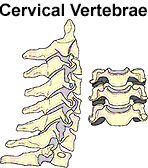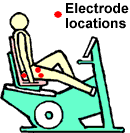 | Promising Progress for Christopher Reeve's Spinal Injury |
 | Promising Progress for Christopher Reeve's Spinal Injury |
| By Erin Hoiland Neuroscience for Kids Consultant October 4, 2002
The AccidentWhile competing in an equestrian contest on May 27, 1995, Reeve's horse stopped suddenly. Reeve was thrown forward, head-first over the horse and landed on the ground in a near-perpendicular position. The weight of Reeve's 6 ft., 4 inch, 230 lb. body shattered his top two vertebrae (cervical 1; C-1 and cervical 2; C-2) and severely damaged his spinal cord.
Magnetic resonance imaging (MRI) showed that Reeve had a severe injury at the C-2 level that left a central fluid-filled cyst surrounded by a narrow donut-shaped rim of white matter. This donut-shaped rim of tissue was the result of cells in the center of the spinal cord dying off because of the injury. This loss of cells prevents the spinal cord from functioning properly and interrupts the transmission of messages between the brain and the rest of the body. Reeve's condition was classified initially as a "Grade A" on the American Spinal Injury Association (ASIA) scale. This classification means that the patient has no sensory or motor function below the shoulders. Reeve was not only paralyzed from the neck down and confined to a wheelchair, but he was unable to breathe without assisted ventilation. A complete description of the five ASIA categories of spinal cord injury is provided in the table below. In the first five years following his traumatic spinal cord injury, Reeve experienced no substantial recovery, and his condition persisted as Grade A injury. Clinical observations of Reeve at the time suggested that he would not have any further recovery.
Treatment of Spinal Cord InjuriesUntil about 10 years ago, it was believed that the adult central nervous system (i.e. the brain and spinal cord) was incapable of regeneration and consequently rehabilitation focused on the immediate post-injury phase to maximize existing function (McDonald et al., 2002). Although immediate post-injury treatment is still important, more recent studies suggest that regeneration of the nervous system is possible. Scientists at Washington University in St. Louis, for example, believe that "encouraging patients to use their injured body parts helps them to recover lost function." The rationale behind this logic is that "forced movements stimulate damaged nerve cells to relearn their jobs" (Washington University, 2002). This logic forms the basis for the Washington University School of Medicine's Activity-Based Recovery Program in which Reeve has participated. Research at Washington University is underway to determine if the rehabilitation approach described below used by Reeve actually promotes neurogenesis, the growth of new nerve cells and the recovery of damaged cells.
Activity-Based RecoveryFive years after his injury, Reeve began the Activity-Based Recovery program. This rehabilitative approach is based on the theory that "patterned neural activity might stimulate the central nervous system to become more functional as it does during development" (McDonald, et. al., 2002). Reeve's program consisted largely of training on a functional electrical stimulation (FES) bicycle and aqua therapy.
Functional Electrical Stimulation (FES)FES involves a specially-designed recumbent bicycle system that uses computer-controlled electrodes placed on a patient's legs to stimulate the leg muscles in specific patterns. Using this technology, a paralyzed person, despite the fact that he is unable to voluntarily control his leg muscles, can rotate the bicycle pedals. In his exercise program, Reeve used the FES bicycle one hour per day three times per week. This activity provided the basic benefits of a physical exercise -- building muscle mass and bone density, reducing spasticity -- and a cardiovascular workout (Christopher Reeve Paralysis Foundation, 2002).
Aqua Therapy Aqua therapy is a type of physical therapy performed in the water. Once
muscle recovery had been stimulated through the use of the FES bicycle,
aqua therapy was added to Reeve's exercise program for one hour per week.
The aqua therapy focused on those muscle groups for which voluntary
control had been recovered during the activity-based recovery program.
The aqua therapy not only enhances the workout of these muscles, but
because the effects of gravity are greatly reduced in water, small body
movements can be more easily detected. This increased ability to detect
small body movements enabled researchers to study Reeve's recovery more
easily and to distinguish deliberate movement from movement caused by
gravit more readily.
Aqua therapy is a type of physical therapy performed in the water. Once
muscle recovery had been stimulated through the use of the FES bicycle,
aqua therapy was added to Reeve's exercise program for one hour per week.
The aqua therapy focused on those muscle groups for which voluntary
control had been recovered during the activity-based recovery program.
The aqua therapy not only enhances the workout of these muscles, but
because the effects of gravity are greatly reduced in water, small body
movements can be more easily detected. This increased ability to detect
small body movements enabled researchers to study Reeve's recovery more
easily and to distinguish deliberate movement from movement caused by
gravit more readily.
Reeve's RecoveryAlthough it is not clear what has led to Reeve's improvement, or if his improvement will continue, Dr. McDonald does offer this speculation:
"One possibility is that a small number of nerves around the site of his injury were left alive but somehow atrophied. The exercise may be reactivating these fibers, allowing signals to pass between the body and brain. Or, the activity is inducing new nerve connections to grow around the site of injury.....The best explanation for this level of recovery is that signals from Mr. Reeve's muscles are reaching his brain." (Blakeslee, 2002) What is the Significance of These Findings?McDonald believes that this case provides the first evidence that substantial recovery of motor and sensory function (two ASIA grades) is possible five to eight years after a severe traumatic spinal cord injury. Although it does not address the reasons for the recovery or the mechanisms of regeneration, this work does demonstrate that delayed recovery is possible and lays the foundation for additional studies examining the role of neural activity in regeneration and recovery of function. | ||||||||||||||
 For references and more
information, see: For references and more
information, see:
|
| GO TO: | Neuroscience In The News | Explore the Nervous System | Table of Contents |
![[email]](./gif/menue.gif) Send E-mail |
 Get Newsletter |
 Search Pages |